Exploring the Reverse Arch Wakeboard Tower
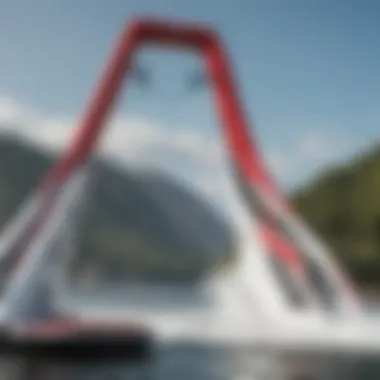
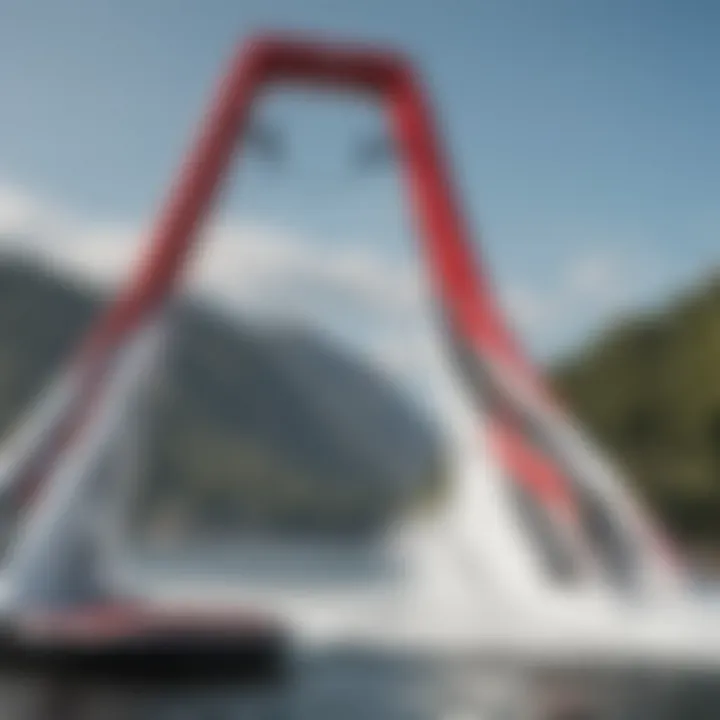
Intro
In the world of watersports, the wakeboard tower plays a crucial role, particularly when discussing the reverse arch wakeboard tower. This innovative design not only offers a sleek aesthetic but also brings practical advantages that can enhance the overall performance of wakeboarding. Understanding the fundamentals of these towers allows both novice and experienced riders to elevate their time on the water.
The reverse arch design differs significantly from its traditional counterparts. By arching backwards instead of forwards, it provides a unique dynamic that improves the angle and height of the towed rider’s arc. This is not just a matter of style; it can be a game-changer in how a wakeboarder engages with the wake. With rising popularity among enthusiasts, grasping the intricacies of reverse arch towers is vital for anyone looking to stay ahead in the game.
Furthermore, recognizing the evolution of these towers helps contextualize their impact on performance. From the engineering aspects to installation and maintenance, each layer of detail contributes significantly to the narrative surrounding wakeboard towers. As we dive deeper into this guide, various techniques, necessary skills, and gear recommendations will ensure readers grasp how to utilize this equipment to the fullest.
Up next, we'll explore essential techniques and skills to get the most out of your wakeboarding experience.
Understanding the Reverse Arch Wakeboard Tower
The reverse arch wakeboard tower is more than just a piece of gear; it’s a game-changer in the watersports arena. When you understand its structure and function, you unlock a new level of performance and enjoyment. This section explores what a wakeboard tower is and why the reverse arch design offers notable advantages.
Defining a Wakeboard Tower
At its core, a wakeboard tower serves as a structural support that elevates the tow point above the boat. This creates a higher pull for riders, enhancing the quality of wake produced. While some boats might just use a standard pylon for towing, a well-designed wakeboard tower dramatically improves stability and control while riding. The tension from the tow rope is better distributed, reducing stress on the boat and providing a solid platform for tricks and jumps.
In contexts like a family outing on the lake or competitive training, the tower becomes essential for a seamless experience. Its height and sturdiness lend to an elevated ride that helps riders perform better, making it a popular choice among enthusiasts.
Overview of Reverse Arch Design
The reverse arch design distinguishes itself by its unique curve, setting it apart from the traditional straight or upward-curved towers. This design not only adds an element of stylistic flair to the boat but also possesses practical advantages. Because of its shape, the reverse arch can reduce wind resistance while slicing through the air. Less drag can equate to better fuel efficiency as well as improved handling, which is particularly beneficial on windy days.
"A well-engineered reverse arch wakeboard tower can turn an ordinary boat into a premium watercraft, ready for anything from leisurely riding to intense competition."
Moreover, this structure offers better overall visibility for both the rider and the boat driver, improving communication and safety. The design facilitates the attachment of various accessories, including speakers and lights, enhancing the social aspect of wakeboarding adventures.
In summary, understanding the components and advantages of a reverse arch wakeboard tower is critical for any watersports enthusiast. It allows for more effective learning and enjoyment while empowering riders to take their skills to the next level.
Historical Context and Evolution
The evolution of wakeboarding and its accompanying technologies has a fascinating narrative, showcasing the sport's rapid development and the innovative designs that enhance its experience. The rise of reverse arch wakeboard towers can be understood better when we peel back the layers of its history and the context in which it flourished. Understanding this context not only highlights the advancements in design but also underscores the community's desire for improving performance, style, and functionality in watersports equipment.
The Rise of Wakeboarding
Wakeboarding, as a sport, sprouted in the late 1980s, blending elements of surfing, snowboarding, and waterskiing. Its birth can be attributed to several enthusiasts who sought new thrills on the water. Initially, wakeboarding was known as "skurfer," a term borrowed from "skurfing," reflecting its roots. Conversation around the sport's origins suggests that people became tired of traditional boating activities and craved something that offered more engagement and excitement.
From the outset, it was more than just a casual pastime. The sport attracted a dedicated fanbase eager for competitions and community gatherings. This demand contributed to a surge in interest from manufacturers, eager to produce specialized equipment, giving rise to wakeboards, bindings, and, importantly, wakeboard towers designed to elevate the rider’s experience. As wakeboarding gained traction, so did its need for enhancing the wake, leading to innovations in tower design that would eventually include the reverse arch style.
Development of Wakeboard Towers
The introduction of wakeboard towers represented a significant shift in boat design. Before towers became common, riders relied on conventional ski pylons for towing, which significantly limited their performance. These older systems often struggled with the height needed for creating optimal wakes for tricks and jumps.
As the sport's popularity grew, so too did the engineers’ realization that a taller tow point — provided by towers — could create a better wake. Thus, the development of wakeboard towers began, transitioning from rudimentary designs to more sophisticated structures that could support higher loads and accommodate various accessories. This innovation, in turn, sparked a new era in wakeboarding.
Notably, the transition to dedicated wakeboard towers showcased various shapes and configurations, including the traditional vertical designs that didn't seem to provide the best performance. And that's where the reverse arch design began to carve its niche.
Transition to Reverse Arch Structures
The reverse arch wakeboard towers emerged as a response to the performance limitations of traditional towers. As riders sought larger and cleaner wakes for tricks, manufacturers explored designs that would optimize the potential of wakeboarding. The transition from classic buoyancy designs to reverse arches changed the game tremendously.
Unlike their predecessors, reverse arch towers boast a unique curvature that redirects water flow, enhancing wake shape and overall height. These towers not only improved functionality but also offered aesthetic appeal to boat designs, harmonizing performance with style.
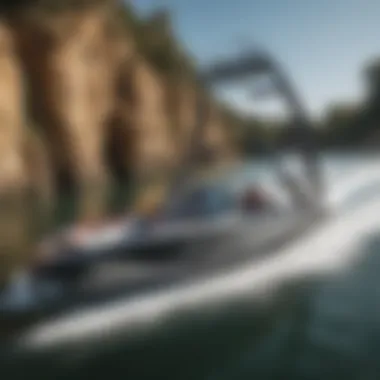
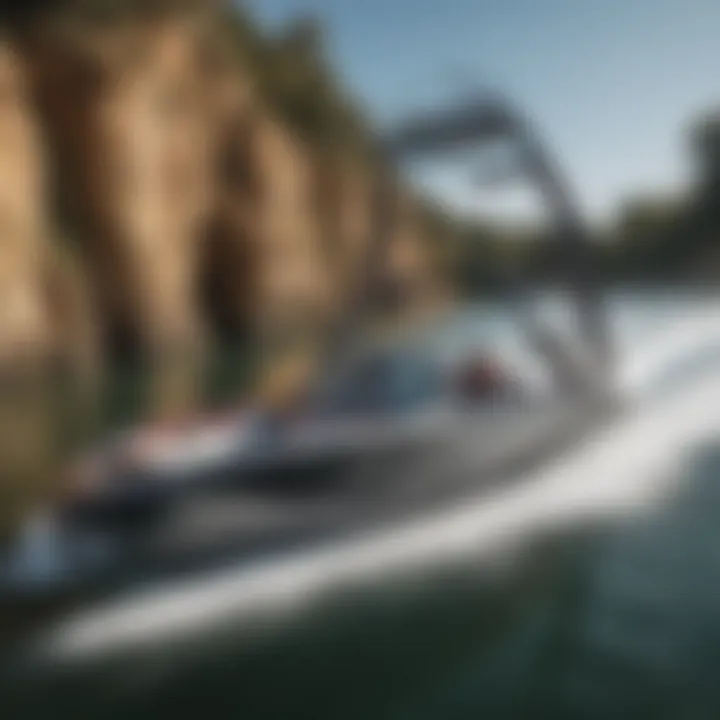
The importance of architecture in wakeboard performance can't be overstated. Here are some benefits of reverse arch structures that contributed to their popularity:
- Improved Aerodynamics: The curved design helps minimize drag, resulting in a smoother ride and better wake formation.
- Enhanced Visibility: The configuration allows the driver and crew to maintain a superior line of sight while towing riders.
- Customization Options: The versatile design enables users to attach various accessories like speakers and lights, enhancing the overall experience.
As we delve deeper into exploring reverse arch towers, we can appreciate not only the engineering novelty they represent but also how they reflect the spirit of innovation in the wakeboarding community, forever shaping the way enthusiasts engage with the water.
Design and Engineering Aspects
When it comes to reverse arch wakeboard towers, understanding the design and engineering aspects is crucial. These towers are not just aesthetic pieces; their construction and performance features directly impact the wakeboard experience. A well-designed wakeboard tower can enhance stability, improve towing characteristics, and boost the quality of the wake produced, making it a vital investment for any watersport enthusiast.
Material Considerations
The construction materials of a wakeboard tower play a significant role in its functionality and durability. Let's break down the prevalent materials used in the industry.
Aluminum vs. Steel
Aluminum towers are gaining popularity for several reasons. One key characteristic is their lightweight nature. This allows for easy installation and reduces the overall weight of the boat, leading to improved fuel efficiency. However, stainless steel towers are also prevalent due to their durability and resistance to deformation under extreme loads. They are often preferred for heavy-duty use.
On the flip side, steel towers can be more susceptible to rust and corrosion if not properly maintained. But their strength compensates for this drawback in many scenarios. Aluminum's unique feature is its natural resistance to corrosion, which makes it a favorite choice for those who want to avoid frequent maintenance. Both options have their upsides, and the best choice often depends on the specific needs of the watersport enthusiast.
Corrosion Resistance
Corrosion resistance is another pivotal factor in material selection. Towers that are exposed to water constantly – saltwater in particular – must have excellent corrosion-proof features. Materials like anodized aluminum and marine-grade stainless steel offer excellent corrosion resistance, extending the lifespan of the tower.
This resistance enhances overall maintenance, allowing for longer periods between checks. It's essential to consider how each material manages electrolysis, especially when using aluminum, as this can influence the boat's longevity and performance.
Weight-to-Strength Ratio
The weight-to-strength ratio is critical in the design of wakeboard towers, as a good balance allows for both structure stability and lightweight construction. Aluminum typically provides a more favorable weight-to-strength ratio compared to steel, making it an advantageous choice for those seeking a robust yet lightweight tower.
This characteristic minimizes unnecessary strain on the boat, enhancing overall performance without compromising safety. However, if a designer aims for maximum load-bearing capacity in heavy-duty applications, steel might be preferred, despite being heavier.
Aerodynamics and Performance
Considering aerodynamics is key when designing a wakeboard tower. Good aerodynamic design can greatly influence the performance of various watersport activities. Let's break down the interplay between aerodynamics and performance further.
Wind Resistance
Wind resistance can affect performance more than you might think. A well-designed reverse arch tower allows for minimal wind resistance while towing, improving fuel efficiency and speed. This design aspect aligns perfectly with the needs of watersport enthusiasts who prioritize quick and agile movement on the water.
The unique shape of reverse arch towers often results in a streamlined effect, reducing drag and allowing the boat to glide smoothly through the water, whether it's skimming at speed or cutting into a turn.
Impact on Wake Shape
The wake shape is vital for those looking to catch air or perform tricks. A properly designed reverse arch wakeboard tower can enhance wake quality by allowing for an optimal angle of tow. This aspect is vital because the right wake shape can make or break a rider’s experience.
With a reverse arch, the pull can create a wide, clean wake that many riders find ideal for jumps, spins, and flips. Uniquely, this design mitigates turbulence issues that can arise with other styles, making it a favored choice among competitive riders.
Stability at Various Speeds
Stability at different speeds is fundamental when navigating challenging waters. A reverse arch tower is designed to maintain stability, even at higher speeds. This stability can reduce the risk of swaying or tipping, enhancing rider confidence.
As one accelerates, the congruence of the tower with the boat's dynamics ensures that the rider has a smoother experience. The design aids in keeping the towed wake consistent, regardless of the speed.
This aspect is especially crucial for instructors and coaches who may need to perform precision maneuvers.
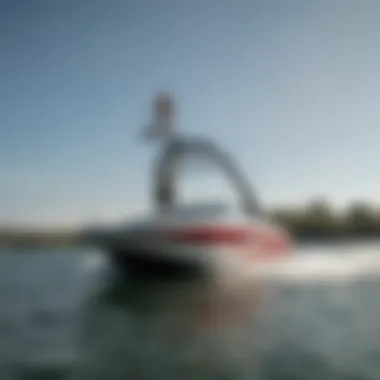
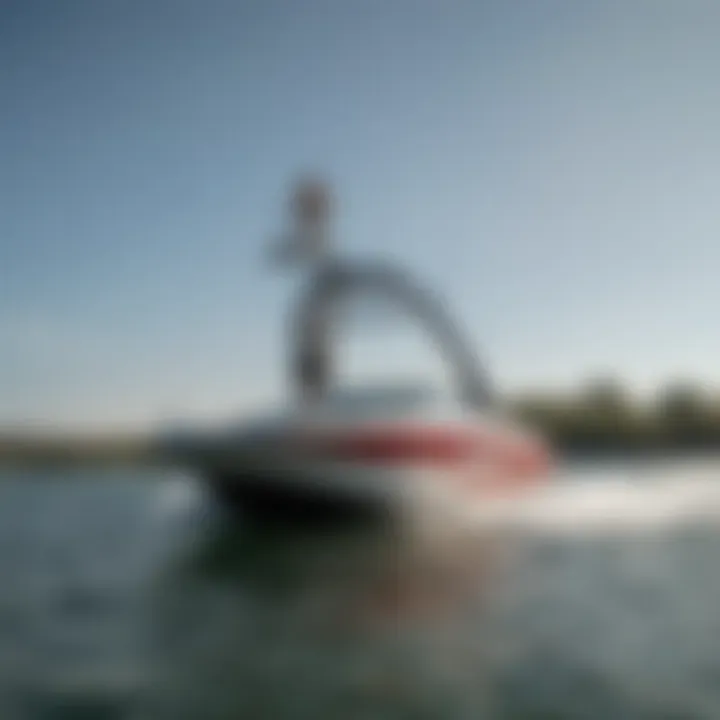
In summary, the design and engineering aspects not only provide structural support but crucially influence performance and experience on the water. Careful consideration of materials, corrosion resistance, weight distribution, and aerodynamics makes a significant difference in the effectiveness and enjoyment of reverse arch wakeboard towers.
Practical Advantages of Reverse Arch Towers
The reverse arch wakeboard tower has gained traction in recent years among watersport enthusiasts, and it's not just a passing trend. These structures offer several practical advantages that enhance both performance and versatility on the water. Understanding these benefits can help both novice and seasoned riders make informed choices regarding their equipment and setup.
Improved Towing Characteristics
Reduced Drag
One of the standout features of reverse arch towers is their ability to significantly reduce drag. This reduction is achieved due to the streamlined design of the arch, which allows the boat to glide more smoothly through the water. When a boat experiences less drag, it translates to better fuel efficiency—an appealing factor for anyone who spends prolonged hours on the water.
A key characteristic of reduced drag is that it not only enhances the speed of the boat but also improves maneuverability. For wakeboarders, this means faster climbs and easier cuts into the wake, translating into a more exhilarating ride. However, it’s crucial to note that while the reverse arch design excels in reducing drag, its effectiveness can be somewhat contingent on boat speed and water conditions.
Enhanced Wake Quality
Another feature worth noting is the positive impact that reverse arch towers have on wake quality. The design actively contributes to the shape and size of the wake, creating a more defined wake that is ideal for tricks and jumps. Riders often note a noticeable difference during their sessions, where the wake produced is not only larger but also cleaner, offering better take-off points for jumps.
The distinctive angle of the reverse arch helps in generating this wake. While some towers might create a steeper or choppier wake, the reverse arch manages to provide a smooth transition. However, a disadvantage might arise when shallow waters are involved since the pronounced wake could potentially be affected by sub-optimal conditions, impacting performance.
Overall Versatility
Suitable for Various Water Activities
Versatility is another major advantage of the reverse arch tower. It's not just built for wakeboarding but is also exceptionally suitable for various water activities. Be it wakesurfing, tubing, or even water skiing, a reverse arch tower accommodates different sports effortlessly. With its robust structure, you can attach a variety of towing accessories without a hitch, allowing for a seamless transition between activities.
This adaptability makes it a favorite among boat owners who might want to cater to different interests in a group setting. However, while embracing versatility is admirable, one must consider the attachment’s compatibility with the tower itself, as not all accessories are designed for every type of tower.
Adaptability for Accessories
Lastly, the adaptability for accessories that reverse arch towers provide cannot be understated. Most towers come equipped with multiple mounting points and can support additional features such as speakers, lights, and even bimini tops. This characteristic opens the door to endless customization possibilities, enhancing the overall boating experience.
This adaptability makes it a great choice for those who want to outfit their boats for all sorts of fun on the water. Yet, this also comes with the caveat of needing to ensure that the added accessories do not overburden the structural integrity of the tower, particularly when performing high-intensity activities.
Overall, the practical advantages of reverse arch towers enrich the boating experience, providing a standout mix of performance, versatility, and the ability to tailor setups to unique needs, whether one is setting out for a casual day or gearing up for a thrilling ride.
Installation and Maintenance Considerations
When it comes to reverse arch wakeboard towers, understanding the installation and maintenance considerations is crucial for both performance and longevity of the equipment. These towers are not just structural components; they play a significant role in enhancing wakesurfing and wakeboarding experiences. Proper installation ensures optimal performance, while regular maintenance guards against wear and tear, resulting in a smooth sailing experience.
Mounting Techniques
Compatibility with Different Boats
A significant factor in mounting reverse arch towers is their compatibility with various boat models. This feature is paramount as it allows wakeboard enthusiasts to adapt the tower to different types of vessels. Some towers are designed to universally fit boats, while others may require specific mounting kits. A notable characteristic of this compatibility is its flexibility. Many manufacturers, like , offer different adapters or custom solutions, ensuring a seamless fit across many boat designs. This versatility is a considerable advantage—carrying over from the installation phase into practical everyday use. It allows wakeboarders to easily switch boats without sacrificing their tower system, making it a popular choice among users.
Yet, compatibility can come with certain disadvantages. For instance, a one-size-fits-all solution may not provide the same level of performance as a tailor-made installation. Care must be taken to ensure that the weight distribution and structural integrity remain intact with different boats.
Optimal Placement
Beyond compatibility, determining the optimal placement for installation is essential. This involves identifying the ideal height and location on the boat for balance and performance. The preferred position on the boat can influence how well the tower works with the boat’s natural dynamics.
One key aspect of optimal placement is the alignment concerning the boat’s center of gravity. Placing the tower too far forward or backward can create an imbalance, affecting performance while towing. It's essential for wakeboarders to focus on positioning the tower where it can enhance the overall balance and stability of the boat during use.
Additionally, this specific placement often translates into aesthetic benefits. An impeccably positioned tower not only performs well but also complements the boat’s looks, adding to its visual appeal. However, poor placement can lead to obstructions in movement or interfere with other accessories, which could logistically pose a hassle during activities such as storage or transport.
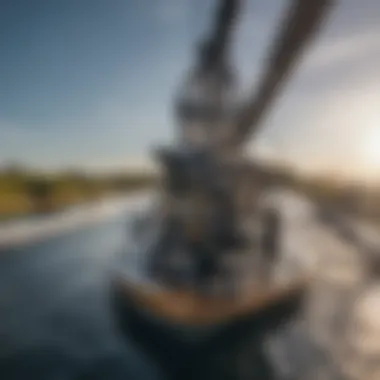
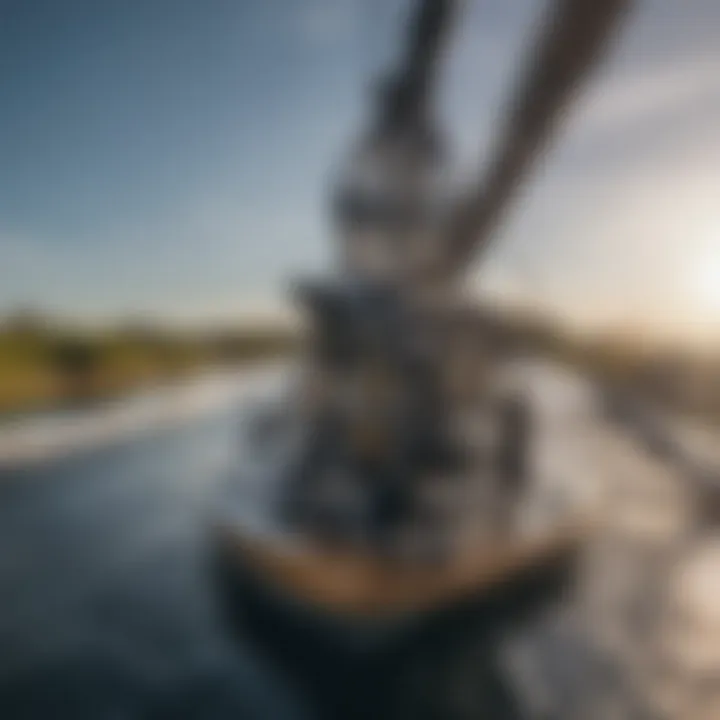
Routine Maintenance Practices
Engaging in regular maintenance practices fortifies the reverse arch tower's functionality and extends its lifespan. Understanding what entails routine maintenance is key to avoiding future headaches.
Inspection Protocols
Conducting regular inspection protocols is essential for keeping the tower in tip-top shape. It involves a systematic examination of the tower for signs of corrosion, wear, and any signs of structural weaknesses. This could include checking the bolts for tightness, ensuring there are no cracks in the metal, and examining the attachment points for the boat. Knowing when to inspect is just as vital as what to inspect.
The beauty of these inspection protocols is how straightforward they can be. Wakeboard enthusiasts can easily implement these checks as part of their pre-season or post-season routines. Having a checklist makes it easier to spot issues on time, which can save money and hassle later on. However, a neglected tower, obvious signs may go unnoticed, leading to safety risks when out on the water.
Cleansing Techniques
Cleansing techniques are equally important in the upkeep of a reverse arch tower. Since these towers are constantly exposed to water and other elements, keeping them clean prevents grime and salt build-up that can lead to damage over time. This simple act can significantly enhance the longevity of the materials used in making the tower.
A common practice among enthusiasts is rinsing the tower with fresh water after each outing. This aids in removing salt deposits, dirt, and other contaminants. Employing mild, marine-safe cleaners can further enhance this process, allowing the structure to shine bright for seasons to come. This cleansing routine is a small investment of time that reaps long-term benefits, making it a wise choice in the journey of enjoying wakeboarding or wakesurfing.
"A well-maintained tower is not just about aesthetics; it’s about performance and safety on the water."
Comparison with Other Tower Designs
When assessing the landscape of wakeboard towers, comparing the reverse arch design with other architectures is key in understanding its distinctive features and benefits. This exploration digs into various tower types, shedding light on functionality, aesthetics, and overall performance in a water sports environment. With the surge in wakeboarding's popularity, knowing which design meets specific needs can greatly influence choices made by enthusiasts, instructors, and manufacturers alike.
Traditional Wakeboard Towers vs. Reverse Arch
Traditional wakeboard towers have long been a staple in the watersports community. They generally feature a straight, vertical structure that serves its purpose; however, they can sometimes fall short in offering the versatility that modern riders seek. On the other hand, the reverse arch wakeboard tower brings a refreshing twist.
One can easily observe the difference in aerodynamics. The reverse arch design not only aids in reducing drag but also enhances overall stability. Lower drag translates into better fuel efficiency which is a crucial factor for any boat owner. Moreover, the arched nature of this design elevates the tow point, providing a cleaner, more defined wake that many wakeboarders are sure to appreciate when they attempt tricks. This minor bump in height may seem insignificant, but the effect on wake shape can be the difference between landing and splashing.
In terms of installation, the reverse arch designs could be perceived as slightly more complicated due to their unique shapes. Traditional models, with their simpler lines, may be quicker to mount on certain boats. However, the trade-off comes into play when considering performance.
Advantages and Disadvantages
Advantages
- Improved Wake Quality: The shape allows for a more pronounced and cleaner wake, enabling better performance in aerial tricks.
- Enhanced Stability: Wind resistance is lowered significantly, which is beneficial for maintaining steadiness during rides.
- Versatility: The reverse arch tower is not limited to wakeboarding; it also accommodates various watersports accessories, making it a multi-functional investment.
Disadvantages
- Complex Installation: Certain models might need bespoke mounting solutions, which can be a sticking point for some boaters who prefer simplicity.
- Cost Implication: The innovative design and materials often come at a premium price compared to traditional setups.
- Weight Considerations: Depending on the materials used, some reverse arch towers may weigh more than traditional counterparts, which can affect boat dynamics.
"Selecting the right wakeboard tower can dramatically alter one's watersport experience, emphasizing the importance of understanding different designs and their implications."
The End
In wrapping up our exploration of the reverse arch wakeboard tower, it's clear that this design marks a significant advancement in the world of watersports. This conclusion not only highlights its importance but also sheds light on crucial elements that sporty enthusiasts should consider when investing in their wakeboarding rig.
The Future of Wakeboard Towers
The development of wakeboard towers has been anything but static. As technology progresses, we can expect to see innovations that take performance, aesthetics, and durability to a new level. For instance, using advanced materials like carbon fiber may greatly reduce weight, enhancing performance without compromising structural integrity.
When we look at the use of aerodynamic simulation tools in the design process, it becomes apparent that future towers could be custom-tuned for individual boat styles and rider preferences. This tailoring could result in wakeboard towers that not only look sleek but also perform with precision under different conditions, be it flat calm water or turbulent waves.
Moreover, the integration of cutting-edge accessories is bound to become more commonplace. Imagine wakeboard towers equipped with smart technology that connects with your smartphone, offering real-time feedback on performance or optimizing wake size for different tricks.
As a community that thrives on adventure, we should also stay attuned to the evolving nature of regulations regarding watersports equipment. Adjustments in safety standards or environmental considerations can shape the options available to consumers. By staying informed, enthusiasts can make educated decisions when selecting a tower that best suits their watersport ambitions.
The durability and multifunctionality of reverse arch designs will continue to appeal to a broad range of activities, from wakeboarding to tubing. But it’s more than just about performance; it’s experiencing the thrill of the ride, the excitement of mastering new tricks, and the joy of making unforgettable memories with friends and family on the water.
In Summary
The future of wakeboard towers is bright and promising, blended with a commitment to innovation and performance. The reverse arch design stands at the forefront of these advancements, appealing to both novice riders and seasoned pros alike, ultimately shaping the landscape of wakeboarding. As we look ahead, there’s no doubt that this will continue to be an exciting time to be part of the watersports community.







